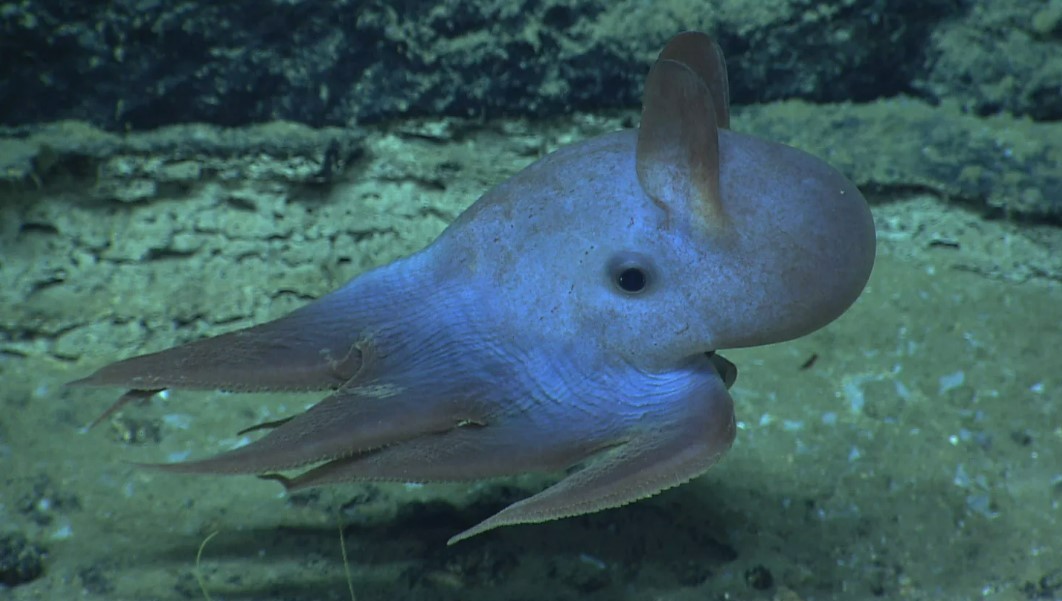
Distribution:
Worldwide, tropical and temperate latitudes
Ecosystem:
Deep-open ocean
Feeding Habits:
Foraging Predator
Taxonomy:
Family Opisthoteuthidae (umbrella octopuses)
Class Cephalopoda (squids, octopuses, and relatives)
Overview
In the deepest part of the ocean living conditions are difficult—there is no light, little food, freezing temperatures, and overwhelming pressure.
But there is a rare creature with a whimsical name that somehow manages to survive in this harsh environment. The Dumbo octopus (genus Grimpoteuthis), named after the Disney elephant that could fly by flapping its ears as wings, lives in the harsh environment of the deep ocean floor (3000 to 4000m or 9800 to 13000 feet) in oceans all around the world.
Physical Characteristics and Habitat
The Dumbo octopus gets its name due to a pair of ear-like fins that protrude just above its eyes. Just like the cartoon elephant, the octopus flaps these fins to propel itself about the ocean floor.
There are 17 known species of Grimpoteuthis, which are a kind of umbrella octopus, characterized by a web of skin in between their arms. They have short, squat, bell-shaped, semi-gelatinous bodies with an internal cartilaginous shell. Most Dumbo octopus average between 20-30 cm (7.9-12 inches) in length, although the largest found was 1.8m (6 foot 32 inches) long and weighed 5.9 kg (13 lbs), a truly elephantine Grimpoteuthis!
Feeding Habits and Predation
The mouth of Dumbo octopus is an underdeveloped or nonexistent beak. This allows them to pounce on prey and swallow them whole. Their diet includes oysters, snails, bristle worms, and small crustaceans, which they find around ocean vent ecosystems or floating along in ocean currents. There are strand-like structures on their suction cups, which allow them to detect their prey and move it to their mouths more easily.
The Dumbo octopus lacks an ink sac that other octopus use as a defense mechanism, so it uses its ability to change color and move quickly to avoid predators. Fortunately, there are few predators for Grimpoteuthis in the deep ocean.
This clip was made by the 2014 Nautilus Live scientist team. They observed the dumbo octopus
swimming along the deep-ocean sea floor off the coast of southern Florida.
Dumbo octopus swim by using a combination of tentacle thrusts and flapping their iconic
elephant-ear-like fins.
Reproduction and Behavior
The deepest depths of the ocean can be a lonely place, and Dumbo octopus are solitary creatures, so they must make the most of any encounters they have with the opposite sex. When Grimpoteuthis meet, the male uses a specialized protuberance on one of its arms that injects an encapsulated sperm packet into the female’s body. The female can then utilize the sperm for fertilization at almost any time. Females can carry batches of eggs in various stages of maturation and lay the eggs under small rocks or shells when the opportunity arises.
Fun Fact
Grimpoteuthis have blue blood because of their blood’s high copper content. Blood with high copper content is more efficient at transporting oxygen in the low-temperature, oxygen-depleted waters of the deep ocean.
For More Information
- “Dance of the Dumbo Octopus” from NOAA Ocean Today
- “Dumbo Octopus” from the Aquarium of the Pacific
- “Dumbo Octopus” from Oceana
- “Grimpoteuthis, the Dumbo Octopus” from the Smithsonian National Museum of Natural History
- “How Many Hearts does an octopus have?” from the New Scientist
This story is part of the “Unleashing the Science” series, showcasing how bureaus within the Department of the Interior produce and apply science to ensure responsible management decisions for our planet now and for the future.
--BOEM--
The Department of the Interior’s Bureau of Ocean Energy Management (BOEM) manages development of U.S. Outer Continental Shelf (OCS) energy, mineral, and geological resources in an environmentally and economically responsible way.

